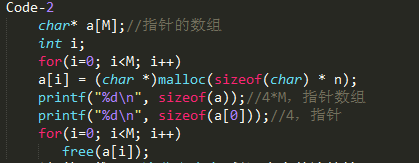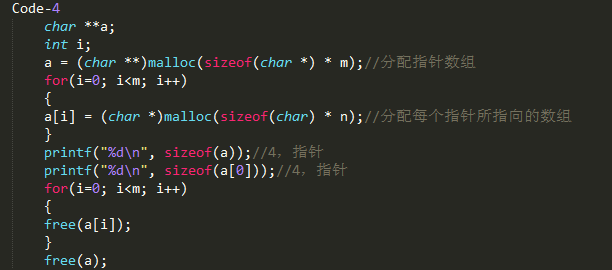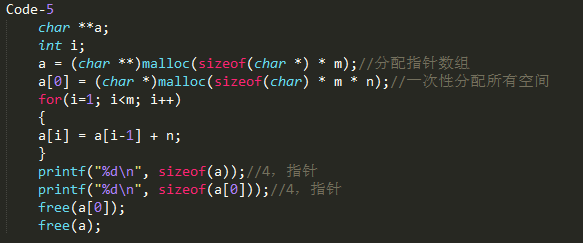c动态语言
函数声明的头文件在<stdlib.h>里


使用malloc函数为字符串分配内存 --》记得释放内存 free()
#include <stdio.h> #include <stdlib.h> #include <string.h> char *concat(const char *s1, const char *s2); int main(void) { char *p; p = concat("abc", "def"); printf("%s ", p); //abcdef return 0; } char *concat(const char *s1, const char *s2) { char *result; result = malloc(strlen(s1) + strlen(s2) + 1); if (result == NULL) { printf("Error: malloc failed in concat "); exit(EXIT_FAILURE); } strcpy(result, s1); strcat(result, s2); //放数据 return result; }
利用动态内存,字符串数组
#include <stdlib.h> #include <stdio.h> #include <string.h> #define MAX_REMIND 50 #define MSG_LEN 60 int read_line(char str[], int n); int main() { char *reminders[MAX_REMIND]; //定义字符串数组 char day_str[3], msg_str[MSG_LEN + 1]; // day_str是为了转换日期用,msg_str是存储字符串,存进数组用 int day, i, j, num_remind = 0; for (;;) { if (num_remind == MAX_REMIND) { printf("-- No space left -- "); break; } printf("Enter day and reminder: "); scanf("%2d", &day); if (day == 0) break; sprintf(day_str, "%2d", day); //把day转换成字符串 read_line(msg_str, MSG_LEN); //输入字符,变成字符串 /* for (i = 0; i < num_remind; i++) { // num_remind记录了有多少个字符串,这个步骤校验有问题,应该放到下面去 printf("ii: %d ",i); if (strcmp(day_str, reminders[i]) < 0) break; } for (j = num_remind; j < i; j++) reminders[j] = reminders[j - 1];*/ reminders[i] = malloc(2 + strlen(msg_str) + 1); //创建动态内存 if (reminders[i] == NULL) { printf("-- No space left -- "); break; } // printf("i: %d ", i); strcpy(reminders[i], day_str); strcat(reminders[i], msg_str); // 放数据 i++; num_remind++; } printf(" Day Reminder "); for (i = 0; i < num_remind; i++) { printf(" %s ", reminders[i]); } return 0; } int read_line(char str[], int n) { char ch; int i = 0; while ((ch = getchar()) != ' ') if (i < n) str[i++] = ch; str[i] = '�'; return i; }
一、 已知第二维

#include <stdlib.h> #include <stdio.h> #include <string.h> #define MAX_REMIND 50 #define MSG_LEN 60 int main() { char (*a)[MSG_LEN + 1]; a = (char (*)[MSG_LEN]) malloc(sizeof(char *) * MAX_REMIND); strcpy(a[0], "abcd"); printf("%s ", a[0]); //abcd; free(a); a = NULL; //防止野指针 return 0; } // 优化后的写法 int main() { char (*a)[MSG_LEN + 1] = malloc(MSG_LEN + 1); if (a == NULL) { printf("malloc error"); exit(1); } strcpy(a, "abcd"); printf("a = %s ", a); free(a); a = NULL; return 0; }
二、 已知第二维

三、 已知第一维, 一次分配内存(保证内存的连续性)

四、两维都未知

五、两维都未知, 一次分配内存(保证内存的连续性)

注意:静态二维数组作为函数参数传递
如果采用上述几种方法动态分配二维数组,那么将对应的数据类型作为函数参数就可以了。这里讨论静态二维数组作为函数参数传递,即按照以下的调用方式:
int a[2][3]; func(a);
C语言中将静态二维数组作为参数传递比较麻烦,一般需要指明第二维的长度,如果不给定第二维长度,则只能先将其作为一维指针传递,然后利用二维数组的线性存储特性,在函数体内转化为对指定元素的访问。
首先写好测试代码,以验证参数传递的正确性:
(1)给定第二维长度
Code-11 void func(int a[][N]) { printf("%d ", a[1][2]); }
(2)不给定第二维长度
Code-12 void func(int* a) { printf("%d ", a[1 * N + 2]);//计算元素位置 }
注意:使用该函数时需要将二维数组首地址强制转换为一维指针,即func((int*)a);